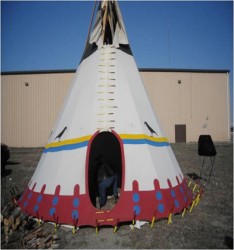Article Origin
Volume
Issue
Year
Seeing homes as assets rather than liabilities has changed the way of living on the Piikani First Nation.
Natoshia Bastien, director and general manager of Piikani Nation Housing and the Ky-naak-ku-kan Housing Corporation, has been rewarded with many successes for the housing management, development and renewal expertise she has brought to the community.
In 2007 the Piikani Nation faced a housing crisis with no new construction or renovation program in 15 years. The Nation was in mortgage arrears and its loan portfolio was due and payable.
“The situation was bleak. Homes were falling apart due to wear and tear from overcrowding and many were condemned by Health Canada and no one wanted to pay,” said Bastien.
Recognizing the need for a plan, Bastien began by looking at the evolution of housing on the Nation from the traditional sweat lodge to the buffalo-hide tipis to the Painted Tipis. In the Painted Tipis she found the key to creating a successful housing plan.
From the Elders Bastien learned that to have a Painted Tipi was an earned honour that identified your role within the community. It was a big responsibility to carry the design of the Painted Tipi.
“If you didn’t take care of your tipi, you would be shunned,” said Bastien.
Reaching back to this model of responsibility and value that didn’t transfer to social housing proved to be successful, although a hard won battle. The objective was to get people to see homes as assets rather than liabilities.
Working with the community, Bastien developed a five-year action plan to improve housing conditions, including a vision, mission and goals. Three main goals were focused on managing, protecting and increasing assets through capacity building, renovation and collection, and access and building. Key strategies included community awareness, individual responsibility through home ownership, health and safety issues, arrears management and long term sustainability.
Two housing branches were developed, one for rentals and one for ownership. The Housing Authority manages the Section 95 portfolio and band-owned rentals, addresses social housing issues and administers the emergency repair program.
“Initially, it was challenging to get people to pay rent, but eventually they came around,” said Bastien.
Many of those who rent now transition to home ownership.
“Housing on the Nation is a closed market since homes can only be bought or sold from other members,” said Bastien.
The ownership model, Ky-naak-ku-kan Housing Corporation, based on the Painted Tipis, supports ownership. Ky-naak-ku-kan consists of a building division with a training partnership and a lending division to provide mortgages and business development.
Employment and training has helped young people learn trades and employed over 90 Nation members.
“We don’t have any gang-related problems or graffiti,” said Bastien.
The federal government’s economic stimulus plan also yielded two new six-plexes for Elders and single parents.
Bastien advises to “approach everyone including internal relationships, staff, community, leadership, government, builders, lenders as partners, rather than in an oppositional way.”
Working together is key to accomplishing much in a short period of time.
“It’s hard to change, but change is necessary,” said Bastien.
- 4975 views

